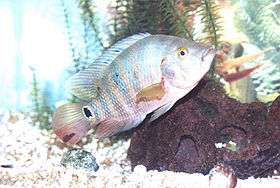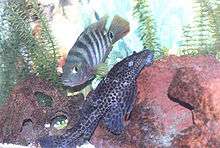Mayaheros urophthalmus
| Mayan cichlid | |
|---|---|
 | |
Not evaluated (IUCN 3.1) | |
| Scientific classification | |
| Kingdom: | Animalia |
| Phylum: | Chordata |
| Class: | Actinopterygii |
| Order: | Perciformes |
| Family: | Cichlidae |
| Subfamily: | Cichlasomatinae |
| Genus: | Mayaheros [1] |
| Species: | M. urophthalmus |
| Binomial name | |
| Mayaheros urophthalmus [1] (Günther, 1862) | |
| Synonyms | |
|
Heros urophthalmus Günther, 1862 Cichlasoma urophthalmum | |
Mayaheros urophthalmus, also known as the Mayan cichlid or Mexican mojarra is a species of cichlid found in Middle America. It is native to the Atlantic slope of tropical Mesoamerica, ranging from eastern Mexico southward to Nicaragua.[2] It was first recorded from Everglades National Park, Florida in 1983 and is now a common nonindigenous fish in South Florida.[3] It has a base color of brown to red that becomes more intense during breeding. As in many animals, the red color is much more brilliant in wild specimens than captive ones, but one can help maintain some of its vibrance by feeding the fish live foods and foods that contain Vitamin A, which breaks down into the red pigment beta-carotene in the body. Previously, this species was a member of the genus Cichlasoma and the subgeneric section Nandopsis. However, the genus Cichlasoma is in revision and has been restricted to the 12 species of South American cichlids related to Cichlasoma bimaculatum. Thus, many of the approximately 100 species that were formerly members of Cichlasoma have yet to be formally assigned to a new genus.[1]
Range and habitat
The Mayan cichlid reaches a maximum length of 39.4 cm.[4] In its native range, the Mayan cichlid is a popular food fish. For this reason it is the basis of a regional fishery, is commonly used in aquaculture, and is among the most-studied of the Neotropical cichlids.[5] To date, the Mayan cichlid has been most intensively studied at localities in southeastern Mexico on or near the Yucatan Peninsula.[6] The Mayan cichlid inhabits lakes, rivers, rocky shorelines, lagoons, esturaries and coastal islands. It can be found in oxygen-rich areas near submerged vegetation and over muddy substrates. However, despite its preference for waters with dissolved oxygen content of at least 3.5 mg/L, it is capable of surviving in extreme hypoxia. This is because it is an oxygen conformer, becoming much less active in hypoxic water, and even surviving virtual anoxia for up to two hours.[6]
The Mayan cichlid is philopatric, or site tenacious, i.e. - individuals are non-migratory and prefer to stay within a home range.[7] The Mayan cichlid has a minimum temperature requirement of about 14 degrees Celsius.[8] In its native range, it inhabits waters with temperatures from 18 - 34 degrees Celsius, but its optimal temperature range is 28 - 33 degrees Celsius.[9] The Mayan cichlid is capable of surviving in a variety of conditions. It is euryhaline and can survive in a range of salinity from 0 - 40 ppt.[5] Experiments on captive specimens have shown that it can tolerate abrupt increases in salinity of up to 15 ppt.[10] The Mayan cichlid has a broad range of tolerance to abiotic conditions and a broad functional repertoire to enable it to feed on about 20% of evasive prey due to its 6.8% jaw protrusion while feeding.[11] This species is also a dietary generalist, consuming organisms from a variety of disparate taxa.[12] However, it is susceptible to malnourishment, apparently due to the requirement that a relatively large proportion of its diet be animal prey.[5]

Reproduction
The Mayan cichlid is territorial and aggressive when breeding.[4] As parents, Mayan cichlids are highly protective of their young, and they have several broods per year. This species is a monogamous, biparental substrate spawner that exhibits minimal sexual dimorphism and guards its fry for up to six weeks. All of these traits are greatly developed and represent an extreme in the general pattern found in the genus Mayaheros. In Mexico, the Mayan cichlid spawns for a nine-month period from March to November, particularly during the wet season from June to September. This corresponds to a period when the water temperature is at least 24 degrees Celsius.[5] Multiple broods are raised per year. The fry appear to be adapted to lotic water. They exhibit strongly positive geotactic behavior, actively swimming down to the substrate upon hatching from the egg and adhering themselves to the bottom by means of three pairs of mucous glands.[5]
See also
References
- 1 2 3 Říčan, O., Piálek, L., Dragová, K. & Novák, J. (2016): Diversity and evolution of the Middle American cichlid fishes (Teleostei: Cichlidae) with revised classification. Vertebrate Zoology, 66 (1): 1-102.
- ↑ Miller, R.R. (1966): Geographical Distribution of Central American Freshwater Fishes. Copeia, 1966 (4): 773-802.
- ↑ Bergmann, G.T. & Motta, P.J. (2005): Diet and morphology through ontogeny of the nonindigenous Mayan cichlid ‘Cichlasoma (Nandopsis)’ urophthalmus (Günther 1862) in southern Florida. Environmental Biology of Fishes, 72 (2): 205-211.
- 1 2 Froese, Rainer and Pauly, Daniel, eds. (2016). "Cichlasoma urophthalmum" in FishBase. January 2016 version.
- 1 2 3 4 5 Martínez-Palacios, C.A., Chávez-Sánchez, C. & Olvera Novoa, M.A. (1993): The potential for culture of the American Cichlidae with emphasis on Cichlasoma urophthalmus. In: Muir, J.F. & Roberts, R.J. (Eds.), Recent advances in aquaculture. Vol. 4., Blackwell, Oxford, England.
- 1 2 Gamboa-Pérez, H.C. & Schmitter-Soto, J.J. (1999): Distribution of cichlid fishes in the littoral of Lake Bacalar, Yucatan Peninsula. Environmental Biology of Fishes, 54 (1): 35-43.
- ↑ Faunce, C.H. & Lorenz, J.J. 2000. Reproductive Biology of the Introduced Mayan cichlid, Cichlasoma urophthalmus, Within an Estuarine Mangrove Habitat of Southern Florida. Environmental Biology of Fishes, 58 (2): 215-225.
- ↑ Stauffer, J.R.Jr. & Boltz, S.E. (1994): Effect of Salinity on the Temperature Preference and Tolerance of Age-0 Mayan Cichlids. Transactions of the American Fisheries Society, 123 (1): 101-107.
- ↑ Martinez-Palacios, C.A., Chavez-Sanchez, M.C. & Ross, L.G. (1996): The effects of water temperature on food intake, growth and body composition of Cichlasoma urophthalmus (Günther) juveniles. Aquaculture Research, 27 (6): 455-461.
- ↑ Martinez-Palacios, C.A., Ross, L.G. & Rosado-Vallado, M. (1990): The effects of salinity on the survival and growth of juvenile Cichlasoma urophthalmus. Aquaculture, 91 (1-2): 65-75.
- ↑ Hulsey, C.D. & García de León, F.J. (2005): Cichlid jaw mechanics: linking morphology to feeding specialization. Functional Ecology, 19 (3): 487-494.
- ↑ Martinez-Palacios, C.A. & Ross, L.G. (1988): The feeding ecology of the Central American cichlid Cichlasoma urophthalmus (Gunther). Journal of Fish Biology, 33 (5): 665-670.